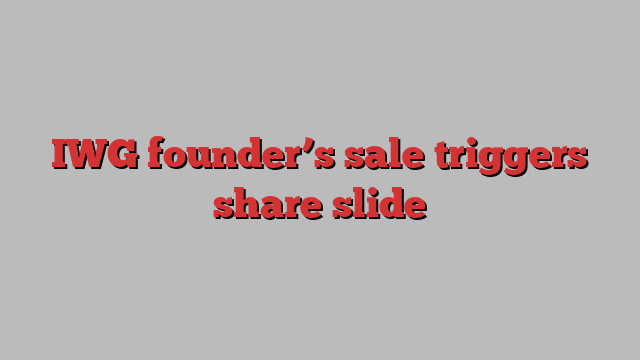
Stay informed with free updates
Simply sign up to the Investments myFT Digest — delivered directly to your inbox.
It’s not every day that a director’s deal triggers an 11 per cent drop in the shares of a FTSE 250-listed entity, but news of a disposal by International Workplace Group’s chief executive, Mark Dixon, did just that.
The size of the disposal clearly played its part. Some 35mn shares were sold by a company linked to Dixon, raising over £68mn. They had been pledged as collateral against a loan Dixon had taken out with Deutsche Bank and were sold to repay these borrowings.
The sale equates to a stake of almost 3.5 per cent in IWG, but Dixon still owns just over a quarter of the company’s shares.
International Workplace Group formally changed its name from IWG last month. It is the parent group behind more than a dozen different brands involved in shared workspaces and virtual offices, the best known being the Regus business founded by Dixon in the late 1980s.
The name change has been accompanied by the shifting of its reporting currency and the denomination of its shares from sterling to US dollars. Although IWG’s Europe, Middle East and Africa arm is still slightly larger than its Americas operations, the group is also considering a change in its accounting standards to the Generally Accepted Accounting Principles used by US companies, from the global International Financial Reporting Standards.
No formal decision has yet been taken, but chief financial officer Charlie Steel argued on an investor call last year that the IFRS16 standard, which requires companies to record lease assets and liabilities on their balance sheet, “might not be the best way to understand how IWG is performing as a business”. This does not excuse three straight years of losses, but he has a point. At the end of last year, IWG’s net debt stood at just over £600mn excluding leases, or £6bn if they’re included.
Rio Tinto exec sells into febrile metals market
Rio Tinto has largely stayed out of the limelight in recent weeks, as BHP and Anglo American tussled over the latter’s prime copper and iron ore assets.
Rio Tinto already has exposure to these commodities, via a new underground operation at Oyu Tolgoi in Mongolia and the upcoming Simandou iron ore project in Guinea. Both of these projects have proved troublesome in the past, but Oyu Tolgoi is now delivering tonnage into a strong copper market and progress at Simandou is finally on the way.
Rio’s share price has risen 8 per cent in the past three months, and chief commercial officer Alf Barrios — who is set to retire this year — last month managed to sell 59,000 shares at a price close to the year’s high of 5,800p.
The market’s eagerness for growth in copper output makes Rio’s forward price/earnings ratio of 9.5 times look mean compared to the 11 times at which BHP trades. That is especially the case given Bernstein analyst Bob Brackett says Rio will slowly catch up to BHP in terms of copper output if the latter does not ramp up significantly in the coming years.
Rio’s current production stands at around 600,000 tonnes a year, while BHP is at over 1mn tonnes, but the gap is forecast to narrow as Rio moves to almost 900,000 tonnes over the next decade. Both companies would also benefit from progress on the Resolution Copper asset in the US, their joint venture in which Rio holds a 55 per cent stake. Brackett calls this a “call option on copper” given the local resistance to it being built.
Rio investor Palliser Capital argued last month the valuation gap between Rio and BHP could be down to the former maintaining primary listings in the UK and Australia, with a discount placed on the London shares. BHP once had a similar structure but dropped this to free up M&A options. Palliser called the current Rio set-up “complex and outdated”, although UK investors hold far more Rio shares than Australian shareholders.